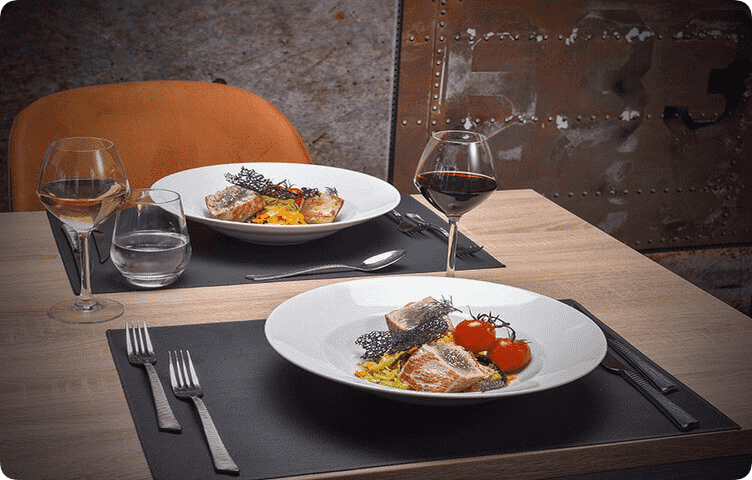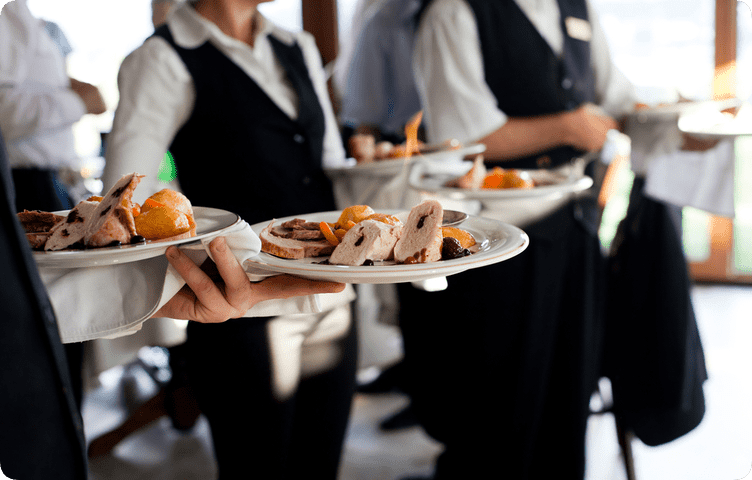The success of the restaurant business depends on the quality of services - delicious food, fast and polite service. Waiters must strictly observe table etiquette. Exquisite serving makes a pleasant impression on guests and helps increase the restaurant’s clientele.
Basic rules for serving dishes
The main task of waiters is to create the most comfortable conditions for customers. Strict adherence to maintenance techniques helps achieve this.

Here are 8 basic rules:
- Food and drinks are delivered only on a tray .
- All dishes that are usually served hot are covered with a serving napkin. For cold appetizers and desserts, a napkin is not required.
- Hot food is served on a plate heated to a temperature of +50ᵒС.
- The dishes are placed on a tray in one row, placing heavier items closer to the waiter.
- Culinary products served in bowls must be shown to guests before serving in portions.
- First of all, appetizers are brought to the table, then main courses, and finally dessert is served.
- Guests should be warned whether the plate is hot, and the name of each dish should be told to them.
- The waiter moves along the table clockwise. Children are served first, then ladies, elderly people, and then men.
In addition to the general rules, the waiter must know in what type of dishes each dish on the menu is served.
Supply of devices

Before starting lunch or dinner, the table is pre-set using four items:
- set of spices ;
- snack plate ;
- wine glass ;
- cloth napkin.
You can also put a vase of flowers or other decorative element. The napkin is placed on the snack plate or to the left of it. The water glass is placed on the right.
After guests place an order, they bring accessories that, according to etiquette, accompany the selected dishes. For example, fish requires a special knife , lobster requires tongs and a two-pronged fork .
The cutlery is placed on the table shortly before the order is served. Forks are placed on the left, knives and spoons on the right. Dessert accessories are placed above the plate. The place of the glasses is on the right, on top. First, a glass of water is served, then wine glasses.
Serving drinks
When alcohol is ordered, the waiter immediately brings everything that is needed for service: the selected bottle, wine glasses, an ice bucket and a corkscrew . First, the bottle is shown to the guest who ordered it, announcing the name of the drink. If the client approves the choice, they begin serving.
Having uncorked the bottle, the waiter places the cork in front of the customer, wet side up. Then you need to pour a little and wait for the client to smell, shake and taste. Only after approval can glasses be filled.
The waiter pours drinks, walking around the table clockwise. The service begins with the ladies and ends with the guest who ordered the bottle.
Cold non-alcoholic drinks are brought in jugs . At the request of clients, the waiter pours into glasses so that the dishes are two-thirds full. Cocktails are served immediately in serving glasses .
Orders for tea and coffee are taken at the end of the meal. Cups and saucers one hundredvyat to the right of spoons and knives.
Rules for serving cold dishes and snacks
A traditional restaurant meal begins with light dishes that stimulate digestion. These include:
- meat, fish, cheese slices;
- salads;
- pates;
- deviled eggs;
- caviar and seafood;
- vegetable and mushroom cocktails.
Cold appetizers are served in portions in porcelain dishes . Dishes with side dishes are placed to the left of the client. If the recipe does not provide a side dish, the appetizer is placed on the right. Culinary products in tall vases are placed in the center of the table, low salad bowls and caviar bowls are placed closer to the guest’s dining area.
Serving soups
Liquid dishes are prepared in special soup bowls, pots or broth bowls . The waiter brings the dishes to the client's right, turning the handle to the right. Seasoned first courses are brought in tureens , from which they are poured into deep plates .
Soups of national cuisines are served in portioned pots. Depending on the rules for serving a particular dish, the contents are poured into a plate or the guest eats directly from the pot.
Serving main courses to the table
Depending on the concept of the restaurant, hot food is served in one of three ways:
Take-out – each guest’s order is brought individually;
To the table – dishes chosen by clients are served in advance in portioned or shared dishes;
Transferring - the waiter first shows the food to the visitors, and after their approval, transfers it to individual plates on the serving table.
Portions are brought in metal or ceramic dishes: lambs , frying pans , pots . If this is required by the etiquette of serving this product, the food is transferred to heated small plates. Cold sauces are served in porcelain gravy boats , hot gravies in metal vessels .
Serving dessert
A meal in a restaurant usually ends with sweet confectionery, fresh fruit or berries. They are brought to guests in portioned bowls or on dessert plates. Some types of hot desserts are released from the kitchen in frying pans or molds, and on the table they are transferred to appropriate dishes.
A dessert spoon is placed to the left of the cutlery. It is intended for desserts served in bowls or bowls. The dessert fork is placed on the right. It is used with baked goods served on a small plate.
Features of serving dishes
In restaurant practice, four service methods are used, each of which has unique rules and traditions:
Russian – waiters bring orders on large trays. Guests take their own food from multi-serving dishes;
French - involves serving “in passing”, in which the waiter directly interacts with customers;
English - portions are served on a utility table;
American - the process of cooking and serving takes place in the kitchen to the right of the visitors, service is carried out on the left.
The restaurant management chooses the style of service in accordance with the theme of the establishment.

Rules for arranging dishes
The banquet or wedding table is set before the guests arrive. Large dishes with snacks are placed in the center. Meat dishes are served in round salad bowls or plates, fish - in oval ones . In the central part, at irregular intervals, sets of spices and salt shakers are placed.lya-hleba/" target="_blank" rel="noreferrer noopener">Bread bins are placed along the edges.
In the second part of the meal, hot food is served in multi-portion dishes. They are placed in the middle of the table. First, fried, boiled, baked fish is served, and then meat or poultry products with side dishes.
Before serving dessert, vases with fruit and dishes with pastries and pies are placed in the center of the tabletop. If tea and coffee are included in the order, sugar bowls and creamers are also placed in the middle.
















































/https%3A%2F%2Fcomplexbar.com%2Fimages%2Fblog%2F132%2FService1-2.png)
/https%3A%2F%2Fcomplexbar.com%2Fimages%2Fblog%2F246%2Fsirop_scale_2400.jpeg)
/https%3A%2F%2Fcomplexbar.com%2Fimages%2Fblog%2F246%2Fkofe-vostochniy.jpg)
/https%3A%2F%2Fcomplexbar.com%2Fimages%2Fblog%2F245%2Fpexels-jason-villanueva-851555.jpg)
/https%3A%2F%2Fcomplexbar.com%2Fimages%2Fblog%2F246%2F2024-04-09_17.22.54.jpg)
/https%3A%2F%2Fcomplexbar.com%2Fimages%2Fblog%2F246%2F2024-04-09_17.22.47.jpg)
/https%3A%2F%2Fcomplexbar.com%2Fimages%2Fblog%2F246%2FCODE_anons_foamydrops_752%D1%85480_eng.jpg)
/https%3A%2F%2Fcomplexbar.com%2Fimages%2Fblog%2F246%2FAlina_752%D1%85480_eng.jpg)
/https%3A%2F%2Fcomplexbar.com%2Fimages%2Fblog%2F246%2F2024-04-09_17.23.22.jpg)
/https%3A%2F%2Fcomplexbar.com%2Fimages%2Fblog%2F246%2F2024-04-09_17.23.28.jpg)
/https%3A%2F%2Fcomplexbar.com%2Fimages%2Fblog%2F246%2F2024-04-09_17.23.35.jpg)
/https%3A%2F%2Fcomplexbar.com%2Fimages%2Fblog%2F246%2Fdrinksome_752%D1%85480_eng.jpg)
/https%3A%2F%2Fcomplexbar.com%2Fimages%2Fblog%2F246%2Fnude_752%D1%85480_eng.jpg)
/https%3A%2F%2Fcomplexbar.com%2Fimages%2Fblog%2F246%2F752%D1%85480_eng__1_.jpg)
/https%3A%2F%2Fcomplexbar.com%2Fimages%2Fblog%2F246%2F752%D1%85480_eng.jpg)
/https%3A%2F%2Fcomplexbar.com%2Fimages%2Fblog%2F246%2FStudioRaw_752%D1%85480_eng.jpg)
/https%3A%2F%2Fcomplexbar.com%2Fimages%2Fblog%2F246%2FDoppio_tea_752%D1%85480_eng.jpg)
/https%3A%2F%2Fcomplexbar.com%2Fimages%2Fblog%2F246%2FTognana_Stars_Stripes_752%D1%85480_eng.jpg)
/https%3A%2F%2Fcomplexbar.com%2Fimages%2Fblog%2F246%2FRona_752%D1%85480_eng.jpg)
/https%3A%2F%2Fcomplexbar.com%2Fimages%2Fblog%2F246%2FDoppio_vending_752%D1%85480_eng.jpg)
/https%3A%2F%2Fcomplexbar.com%2Fimages%2Fblog%2F246%2FEssence_sukhie_smesi_752%D1%85480_eng.jpg)
/https%3A%2F%2Fcomplexbar.com%2Fimages%2Fblog%2F246%2FODK_sukhie_smesi752%D1%85480_eng.jpg)
/https%3A%2F%2Fcomplexbar.com%2Fimages%2Fblog%2F246%2Funiforma-barmena.jpg)
/https%3A%2F%2Fcomplexbar.com%2Fimages%2Fblog%2F246%2Fkak-nanyat-barmena.jpg)
/https%3A%2F%2Fcomplexbar.com%2Fimages%2Fblog%2F246%2Fsirop_scale_2400.jpeg)
/https%3A%2F%2Fcomplexbar.com%2Fimages%2Fblog%2F246%2FPeugeot_Anons_Paris_U%27Select_Line_Daman_752%D1%85480_eng.jpg)
/https%3A%2F%2Fcomplexbar.com%2Fimages%2Fblog%2F246%2Fkofe-vostochniy.jpg)
/https%3A%2F%2Fcomplexbar.com%2Fimages%2Fblog%2F246%2FMadler.jpg)
/https%3A%2F%2Fcomplexbar.com%2Fimages%2Fblog%2F246%2Fprofbartender_glavn.jpeg)